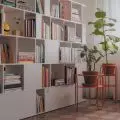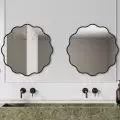Urban planning significantly affects people with ADHD. Research suggests that certain architectural and urban planning assumptions can alleviate symptoms, while others can exacerbate them.
ADHD (from attention deficit hyperactivity disorder) is an attention-deficit/hyperactivity disorder characterized by a persistent pattern of inattention and/or hyperactivity and impulsivity that interferes with "typical" functioning. People with ADHD experience a continuous pattern of symptoms. The World Health Organization estimates that the syndrome is one of the most common mental disorders[1]. It affects 5-8% of children, mostly boys, and persists into adulthood. Similar results are noted regardless of world region, race and culture[2].
Can the city exacerbate ADHD symptoms?
The city is the key spatial context of daily life for most people. Naturally, neurodiverse people also appear in this conglomerate. For them, however, staying, moving around in the city can be challenging due to the complex, unpredictable nature of the urban fabric.
Theimmediate environment plays a huge role in the appearance of ADHD symptoms. Urban areas with high levels of noise, pollution and visual stimulation can overwhelm individuals, leading to increased stress and difficulty concentrating. Conversely, well-designed urban spaces can help alleviate symptoms, or at least not exacerbate them. While urban planning alone cannot cure ADHD, thoughtful design can help alleviate some symptoms and create spaces that are more conducive to focus, relaxation and overall well-being.
recipe
What is the recipe for a kind space for people with ADHD? It's likely that a typical person wouldn't distinguish it from a regular place where they feel comfortable. This is because, first of all, such a place would be integrated with green spaces. Incorporating more parks, gardens and natural areas into the urban environment can reduce stress and improve the ability to focus for people not only with ADHD, sometimes just stressed by work, having a worse day. Increasing access to green spaces and nature has been shown to have a positive effect on ADHD symptoms. It is worth creating more parks, gardens and natural areas in urban environments, ensuring that these spaces are easily accessible to residents. They should include a variety of natural elements, such as trees, water features and varied terrain. In cities with more green spaces and parks, people are less likely to be diagnosed with ADHD symptoms.
Here we can also talk about the need to implement biophilic design, which integrates nature into the built environment. The introduction of green walls and gardens on the roofs of buildings, the planting of streets with trees and the creation of urban forests contribute to more welcoming and relaxing spaces. In addition, the use of natural materials and textures in architecture and public spaces helps create a harmonious environment that positively affects the well-being and concentration of people with ADHD.
Second, ADHD-friendly spaces are pedestrian- and bicycle-friendly neighborhoods. Walkable neighborhoods that encourage physical activity can help manage ADHD symptoms. Urban planning for people with ADHD should include active transportation. It is worth creating places that are conducive to pedestrians and cyclists by designing neighborhoods that encourage movement. To achieve this, create wide sidewalks, safe DDRs and introduce traffic calming measures to increase safety. It is also important to provide mixed-use developments that allow easy access to daily needs.
Reducing noise pollution is particularly important for people with ADHD, and can be achieved through strategic land use and the use of sound barriers. It is worthwhile to introduce strategies to reduce urban noise, such as using sound-absorbing materials in construction, creating buffer zones between noisy areas (e.g., highways, railroads) and residential areas, and implementing noise laws and regulations. Designating and designing special areas for relaxation and concentration, such as "quiet places" or sections in parks, and libraries and community centers with noise-reduction features, is also important for improving the comfort of people with ADHD.
People with ADHD can function much better in properly designed public spaces that are structurally organized and well-marked. Incorporating clear and intuitive navigation systems, such as consistent and easily understood signage, digital navigation tools and maps, is key. Designing logical and simple street layouts also contributes to easier movement. Use storage solutions and regular maintenance schedules to create orderly public spaces that reduce visual chaos. Using zoning to separate different activities in public spaces promotes better functioning.
Designing sensory-friendly spaces is important so people can feel less overwhelmed[3]. One aspect of such design is proper lighting [4]. It is useful to use natural light where possible, avoid harsh or flashing artificial lighting, and provide adjustable lighting. Colors and patterns also have a significant impact on visual stimulation. Public spaces should use calming color palettes and avoid overly complex patterns on floors and walls.
all for the better
By creating urban spaces that prioritize these elements, cities can become more inclusive and supportive of people with ADHD, potentially reducing the incidence and severity of symptoms. This approach not only helps people with ADHD, but also supports the overall well-being of all residents. It's worth noting that many of these solutions align with recommendations for creating dementia-friendly urban spaces, which is increasingly important in an aging society. In addition, greenery in cities not only improves quality of life, but also contributes to the cooling of spaces, which is crucial in the context of urban heat islands and hot weather. The application of these strategies can therefore contribute to creating more climate-resilient urban environments.
Magdalena Milert
[1] https:// i ris.who.int/handle/10665/364129
[2] Kooij S.J. et al, European consensus statement on diagnosis and treatment of adult ADHD: The European Network Adult ADHD, "BMC Psychiatry," 10, 2010, p. 67, DOI: 10.1186/1471-244X-10-67
[3] https://www.architecturaldigest.com/reviews/home-improvement/sensory-processing-disorder
[4] https://www.eaton.com/tw/en-us/company/news-insights/lighting-resource/connected-lighting/best-lighting-for-adhd-migraines-and-other-neurological-conditions.html
https://www.nimh.nih.gov/health/topics/attention-deficit-hyperactivity-disorder-adhd
Douglas, O., Lennon, M., & Scott, M. (2017). Green space benefits for health and well-being: A life-course approach for urban planning, design and management. Cities, 66, 53-62.
Mennis, J., Mason, M., & Ambrus, A. (2018). Urban greenspace is associated with reduced psychological stress among adolescents: A Geographic Ecological Momentary Assessment (GEMA) analysis of activity space. Landscape and urban planning, 174, 1-9.
Fennelly, L. J., & Perry, M. A. (2018). Depression, Dementia, ADHD, Schizophrenia, Alzheimer's, and CPTED. In CPTED and Traditional Security Countermeasures (pp. 300-307). CRC Press.
Kenna, T. (2023). Neurodiversity in the city: Exploring the complex geographies of belonging and exclusion in urban space. The Geographical Journal, 189(2), 370-382.














